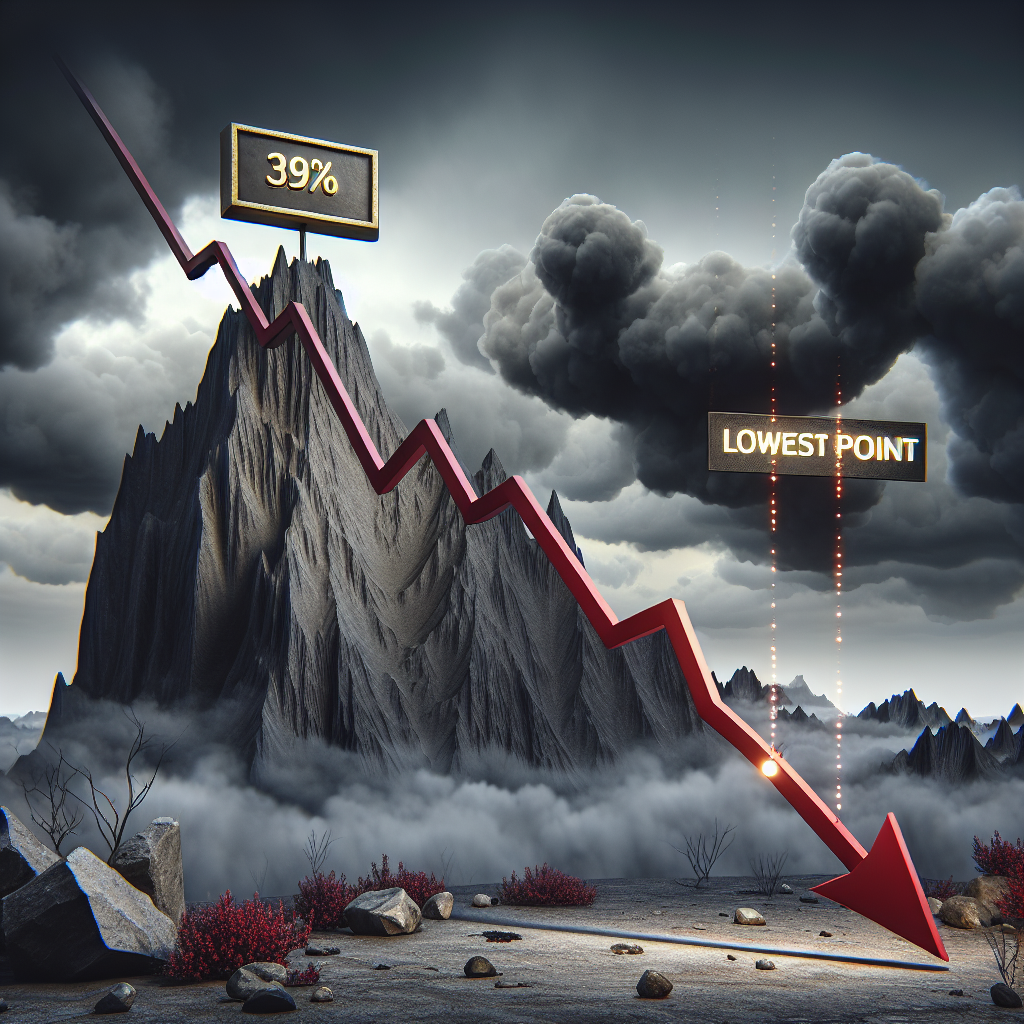-
Table of Contents
- Home Sales Plummet to Near-Record Low Amid Rising Prices
- Understanding the Current Market Dynamics
- Supply and Demand Imbalance
- Rising Home Prices
- The Impact on Potential Buyers
- Affordability Challenges
- Increased Competition
- The Broader Economic Implications
- Economic Growth
- Housing Market Stability
- Social Equity
- Case Studies: Regional Variations
- San Francisco Bay Area
- Austin, Texas
- Potential Solutions and Policy Interventions
- Increasing Housing Supply
- Addressing Affordability
- Promoting Financial Literacy
- Conclusion
Home Sales Plummet to Near-Record Low Amid Rising Prices

The real estate market is experiencing a significant downturn as home sales plummet to near-record lows. This decline is largely attributed to rising home prices, which have made it increasingly difficult for potential buyers to enter the market. In this article, we will explore the factors contributing to this trend, examine its impact on various stakeholders, and discuss potential solutions to mitigate the issue.
Understanding the Current Market Dynamics
The housing market is a complex ecosystem influenced by a myriad of factors. To understand the current decline in home sales, it is essential to examine the interplay between supply and demand, interest rates, and economic conditions.
Supply and Demand Imbalance
One of the primary reasons for the drop in home sales is the imbalance between supply and demand. The inventory of available homes has been shrinking, leading to increased competition among buyers. This scarcity has driven up prices, making it difficult for many to afford a home.
- According to the National Association of Realtors (NAR), the inventory of homes for sale in the U.S. was down 20% year-over-year as of the latest report.
- New home construction has not kept pace with demand, further exacerbating the shortage.
Rising Home Prices
Home prices have been on an upward trajectory for several years, but the rate of increase has accelerated recently. Several factors contribute to this trend:
- Material Costs: The cost of building materials, such as lumber and steel, has surged due to supply chain disruptions and increased demand.
- Labor Shortages: The construction industry is facing a labor shortage, leading to higher wages and, consequently, higher construction costs.
- Inflation: General inflationary pressures have also contributed to rising home prices.
According to the S&P CoreLogic Case-Shiller U.S. National Home Price Index, home prices increased by 19.7% year-over-year in the latest report, marking one of the highest annual gains on record.
The Impact on Potential Buyers
The surge in home prices has had a profound impact on potential buyers, particularly first-time homebuyers and those with limited financial resources.
Affordability Challenges
As home prices rise, affordability becomes a significant barrier for many buyers. The combination of higher prices and stagnant wage growth has made it increasingly difficult for individuals and families to save for a down payment and qualify for a mortgage.
- According to a report by the Urban Institute, the median home price in the U.S. is now more than four times the median household income, making homeownership out of reach for many.
- The NAR’s Housing Affordability Index, which measures the ability of a typical family to afford a home, has declined steadily over the past year.
Increased Competition
The limited inventory of homes for sale has led to intense competition among buyers. Bidding wars have become commonplace, driving prices even higher and often resulting in homes selling for well above their asking prices.
- A survey by Redfin found that 70% of home offers faced competition in the latest quarter, with the average home selling for 2.8% above its list price.
- This competitive environment has forced many buyers to make concessions, such as waiving inspections or offering all-cash deals, to secure a home.
The Broader Economic Implications
The decline in home sales and rising prices have broader economic implications that extend beyond individual buyers and sellers. These trends can impact the overall economy, housing market stability, and social equity.
Economic Growth
The housing market is a significant driver of economic growth. When home sales decline, it can have a ripple effect on various sectors of the economy, including construction, real estate services, and consumer spending.
- According to the National Association of Home Builders (NAHB), the housing market contributes approximately 15-18% of the U.S. GDP.
- A slowdown in home sales can lead to reduced demand for construction materials, appliances, and home furnishings, impacting related industries.
Housing Market Stability
Rising home prices and declining sales can also affect the stability of the housing market. If prices continue to rise at an unsustainable rate, it could lead to a housing bubble, similar to the one experienced in the mid-2000s.
- Economists warn that a sudden correction in home prices could result in a significant number of homeowners being “underwater,” owing more on their mortgages than their homes are worth.
- This scenario could lead to increased foreclosures and financial instability for many households.
Social Equity
The current housing market dynamics also have implications for social equity. Rising home prices disproportionately affect low-income and minority households, exacerbating existing disparities in homeownership rates and wealth accumulation.
- According to the Urban Institute, the homeownership rate for Black households is nearly 30 percentage points lower than that of White households.
- The affordability crisis can further widen this gap, limiting opportunities for wealth building and economic mobility for marginalized communities.
Case Studies: Regional Variations
While the overall trend of declining home sales and rising prices is evident nationwide, there are regional variations that provide additional insights into the dynamics of the housing market.
San Francisco Bay Area
The San Francisco Bay Area is one of the most expensive housing markets in the country. The region has seen a significant decline in home sales due to skyrocketing prices and limited inventory.
- According to the California Association of Realtors (CAR), home sales in the Bay Area were down 25% year-over-year in the latest report.
- The median home price in San Francisco reached $1.8 million, making it one of the least affordable markets in the U.S.
The high cost of living and remote work trends have prompted many residents to relocate to more affordable areas, further impacting the local housing market.
Austin, Texas
Austin, Texas, has experienced rapid population growth and a booming tech industry, leading to increased demand for housing. However, this demand has outpaced supply, resulting in rising prices and declining sales.
- The Austin Board of Realtors reported a 15% decline in home sales year-over-year, despite a 30% increase in median home prices.
- The influx of tech workers and remote employees from other states has contributed to the competitive market and rising prices.
The city’s efforts to increase housing supply through new construction have been hampered by regulatory challenges and labor shortages.
Potential Solutions and Policy Interventions
Addressing the decline in home sales and rising prices requires a multifaceted approach involving policy interventions, market adjustments, and innovative solutions. Here are some potential strategies to consider:
Increasing Housing Supply
One of the most effective ways to address rising home prices is to increase the supply of available housing. This can be achieved through various means:
- Zoning Reforms: Local governments can implement zoning reforms to allow for higher-density housing and reduce regulatory barriers to new construction.
- Incentives for Builders: Providing incentives, such as tax breaks or subsidies, to builders can encourage the development of affordable housing.
- Public-Private Partnerships: Collaborations between public agencies and private developers can facilitate the construction of mixed-income housing projects.
Addressing Affordability
To make homeownership more accessible, policymakers can implement measures to address affordability challenges:
- Down Payment Assistance: Programs that provide down payment assistance or low-interest loans can help first-time homebuyers overcome financial barriers.
- Mortgage Rate Subsidies: Subsidizing mortgage rates for low- and moderate-income buyers can reduce monthly housing costs and increase affordability.
- Rent-to-Own Programs: Expanding rent-to-own programs can provide a pathway to homeownership for renters who may not have the means for a traditional down payment.
Promoting Financial Literacy
Improving financial literacy and education can empower potential buyers to make informed decisions and navigate the complexities of the housing market:
- Homebuyer Education: Offering homebuyer education programs can help individuals understand the homebuying process, budgeting, and mortgage options.
- Credit Counseling: Providing access to credit counseling services can assist buyers in improving their credit scores and qualifying for better mortgage terms.
Conclusion
The decline in home sales to near-record lows amid rising prices is a multifaceted issue with far-reaching implications. The imbalance between supply and demand, coupled with rising construction costs and economic pressures, has created a challenging environment for potential buyers. This trend not only affects individual households but also has broader economic and social consequences.
Addressing this issue requires a comprehensive approach that includes increasing housing supply, implementing affordability measures, and promoting financial literacy. By taking proactive steps, policymakers, industry stakeholders, and communities can work together to create a more stable and equitable housing market.
In conclusion, while the current state of the housing market presents significant challenges, it also offers an opportunity for innovative solutions and collaborative efforts to ensure that homeownership remains an attainable goal for all.








